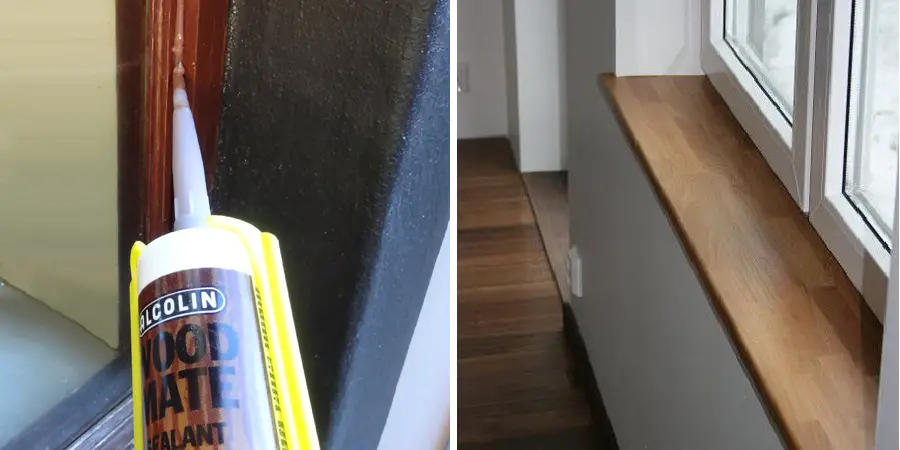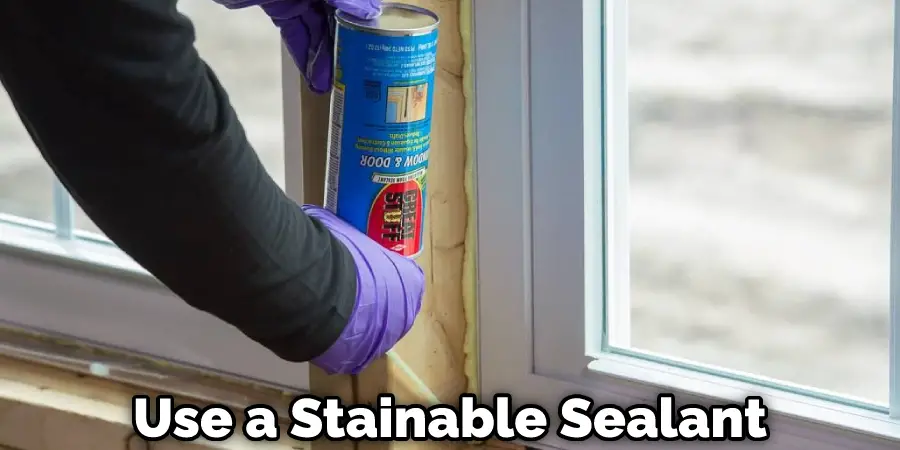If you live in a home with wooden windows, then you know the importance of keeping them sealed and well-maintained. A properly sealed window frame will help keep your home warm in the winter and cool in the summer while also protecting it from the elements. This article will show you how to seal a wooden window frame. Keep reading to learn more.

What Causes Wooden Window Frames to Crack?
There are a few different things that can cause wooden window frames to crack. One of the most common causes is the expansion and contraction of the wood due to changes in temperature and humidity. This can cause the wood to warp, which can eventually lead to cracking. Another common cause of cracking is impact damage. If something hits your window frame hard enough, it can cause the wood to crack. The other main cause of cracking is rot. If the wood on your window frame is not properly sealed, it can absorb moisture from the air and start to rot. This can also lead to cracking.
Why Should You Seal Wooden Window Frames?
Sealing your wooden window frames is important for a few different reasons. First, it will help to prevent the wood from cracking. Second, it will help to keep your home more energy-efficient by preventing drafts. Third, sealing the wood will help protect it from the elements and rot. Another reason to seal your wooden window frames is to improve the appearance of your home.
If the wood on your window frames is cracked, discolored, or otherwise damaged, it can make your home look unappealing. Sealing the wood will help to conceal any damage and give your home a more polished look. Finally, sealing your wooden window frames can also increase the value of your home. If you ever decide to sell, potential buyers will be impressed by the fact that you took the time to seal the wood and protect your investment.
Step by Step How to Seal a Wooden Window Frame:
1. Inspect the Wood
The first step in sealing your wooden window frames is to inspect the wood. Look for any cracks, warping, or other damage. If you find any damage, you will need to repair it before you can seal the wood. Next, inspect the wood for rot as well. If the wood is starting to rot, you will need to replace it before sealing it.

You should also check the caulking around the window frame. If it is old or cracked, you will need to remove it and replace it with new caulk before sealing the wood. The caulking is important for creating an airtight seal and preventing drafts.
2. Choose the Right Type of Sealant
There are a variety of sealants available on the market, so you will need to choose the right type for your project. If you are sealing wood that will be exposed to the elements, you will need to use a water-resistant sealant. If you are sealing wood that will not be exposed to the elements, you can use a less expensive sealant.
It is also important to choose a sealant that is safe for use on wood and will not cause discoloration or other damage.
3. Prepare the Wood
Before applying the sealant, you should prepare the wood by sanding it down. This will help to smooth out any rough edges and create a clean surface for the sealant to adhere to. Make sure to sand in the direction of the wood grain to avoid any damage. It is also important to clean the wood thoroughly to remove any dust or debris.
It may also be helpful to use a wood primer before applying the sealant. This will help the sealant adhere better and provide an extra layer of protection for the wood. You can also choose a tinted primer to help conceal any discoloration on the wood.
4. Repair Any Damage
If you find any cracks, holes, or other damage, you will need to repair them before you can seal the wood. Small cracks can be filled with wood filler. Larger cracks may require the use of a splint or other type of support. Holes can be filled with wood putty. If the damage is severe, you may need to replace the damaged piece of wood.
There are also wood repair kits available that can help you fix any damage to your wooden window frames. It is important to complete these repairs before moving on to the next step.
5. Remove Old Sealant
If the wood has been previously sealed, you will need to remove the old sealant before applying the new sealant. You can use a putty knife to scrape off the old sealant. First, use the putty knife to loosen the old sealant. Then, use a brush to remove the loosened sealant. If the old sealant is difficult to remove, you can use a chemical stripper.
You may also need to sand down the wood again after removing the old sealant to create a smooth surface for the new sealant. The wood should also be cleaned again to remove any debris.
6. Sand the Wood
Once the wood is cleaned and repaired, you need to sand it. This will help to create a smooth surface for the sealant to adhere to. Use a piece of sandpaper to sand the wood. First, use coarse-grit sandpaper to remove any roughness. Then, use fine-grit sandpaper to create a smooth surface. If you are sealing wood that will be exposed to the elements, you may need to use a power sander.

You can also use the sandpaper to remove any old paint or stain from the wood. This will help the new sealant adhere better and provide a more uniform finish. It may also be necessary to clean the wood again after sanding to remove any dust or debris.
7. Apply Caulk
After sanding the wood, you will need to apply the caulk. Caulk is a type of sealant that is used to fill gaps and cracks. It will help to create a weather-proof seal around your windows. Apply the caulk around the perimeter of the window frame. Use a putty knife to smooth the caulk.
It is important to use a silicone-based caulk that is specifically designed for use on wood. This type of caulk will adhere better and provide better protection against the elements. You can also choose a caulk that is tinted to match the color of your wood.
8. Apply Primer
After applying caulk, you will need to apply primer. Primer is a type of paint that helps the sealant to adhere to the wood. It will also help to create a barrier between the wood and the sealant. Apply the primer with a paintbrush. First, paint the corners and edges of the window frame. Then, paint the rest of the frame. Make sure to cover all of the exposed wood.
Otherwise, the sealant may not adhere properly and could peel or crack over time. You can also choose a tinted primer to help conceal any discoloration on the wood. The primer will also help to create a more uniform finish.
9. Use a Stainable Sealant
If you want the sealant to match the color of the wood, you will need to use a stainable sealant. Stainable sealants are available in a variety of colors. Choose a color that closely matches the color of the wood. Apply the sealant with a brush or a roller. Allow the sealant to dry for 24 hours before staining it. Stain the sealant with a matching wood stain color. Allow the stain to dry for 24 hours before applying a top coat of sealant.

It is important to follow the manufacturer’s instructions for drying times and application methods. Failure to do so could result in a poor finish or reduced effectiveness of the sealant.
10. Use a Polyurethane Sealant
If you want to create a durable, water-resistant seal, you will need to use a polyurethane sealant. Polyurethane sealants are available in clear and tinted formulas. Choose a clear formula if you want the natural color of the wood to show through. Choose a tinted formula if you want the sealant to match the color of the wood. To use a polyurethane sealant, clean the wood’s surface with a damp cloth. Then, apply the sealant to the surface of the wood using a brush or a sponge. Allow the sealant to dry for 24 hours before applying a second coat.
You can also use a spray-on polyurethane sealant for easier application. However, make sure to cover any nearby surfaces or objects to avoid getting overspray on them. It is also important to follow the manufacturer’s instructions for drying times and reapplication intervals.
11. Use an Oil-based Sealant
If you want to create a durable, water-resistant seal, you will need to use an oil-based sealant. Oil-based sealants are more difficult to apply and take longer to dry. However, they will create a stronger seal lasting many years. Apply the sealant to the window frame with a brush, and then use a rag to remove any excess. Allow the sealant to dry for 24 hours before painting or staining the window frame.
It is important to note that oil-based sealants may have a strong odor and can be harmful if inhaled. Make sure to work in a well-ventilated area and take breaks as needed.
12. Use a Waterproofing Sealant
You will need to use a waterproofing sealant to create a waterproof seal. Waterproofing sealants are available in clear or tinted formulas. You can also find them in aerosol cans or tubes that you can apply with a caulking gun. To create a waterproof seal, apply the sealant to the gap between the window frame and the wall.
Use a putty knife or your finger to smooth out the sealant. The goal is to create a continuous seal that will keep water out and prevent leaks. Once the sealant is dry, you can paint or stain the window frame if desired.

It is important to check the manufacturer’s instructions for specific drying times and reapplication intervals. This will ensure that the sealant is effective and long-lasting. In addition, make sure to clean and prepare the surface properly before applying the sealant, as this can greatly affect its effectiveness.
13. Apply a Top Coat
After applying the sealant, you will need to apply a top coat. This will help to protect the sealant and create a more durable finish. You can use paint or varnish for this purpose. Be sure to apply the top coat in a well-ventilated area and follow the manufacturer’s instructions. If you are using paint, you may need to apply multiple coats to achieve the desired results. Once the top coat has dried, your window frame should be properly sealed and protected from the elements.
Following these steps on how to seal a wooden window frame will help you properly seal your window frame and ensure that it is protected from the elements. This will not only improve the appearance of your windows, but also help to prevent damage and prolong their lifespan. So next time you notice gaps or cracks around your window frames, remember to follow these steps to effectively seal them.
Do You Need to Use Professional Support?
While sealing wood windows may seem like a relatively straightforward task, it can be time-consuming and requires attention to detail. If you are not confident in your abilities or do not have the necessary tools and equipment, it may be best to hire professionals for assistance. They will have the expertise and experience needed to ensure that the job is done correctly and efficiently.
Additionally, hiring professionals can give you peace of mind and save you time and effort. So, consider your options carefully before deciding whether to hire professionals or tackle the task yourself. In either case, properly sealing your wood windows is crucial for protecting them from damage and maintaining their beauty for years to come.
How Much Does It Cost To Seal a Wooden Window Frame?
Normally, it would cost you around $200 to seal a typical wooden window frame. However, the cost of sealing a wooden window frame will vary depending on the type of sealant you use. Waterproofing sealants and oil-based sealants are more expensive than latex sealants. However, they will create a stronger and more durable seal. If you plan to stain or paint the window frame, you will also need to factor in the cost of these materials. It is usually cheaper to seal a wooden window frame before installing it. This will save you time and money in the long run.
Additional Tips:
- Make Sure to Read and Follow the Manufacturer’s Instructions for Each Product Carefully.
- Wear Protective Gear Such as Gloves and Goggles When Working With Sealants.
- Allow Proper Drying Time Between Each Step for Best Results.
- Regularly Check Your Sealed Wooden Window Frames for Any Signs of Wear or Damage, and Reseal Them if Necessary.
- Remember That Prevention is Key for Maintaining the Integrity of Your Wooden Window Frames. Consider Sealing Them as Soon as Possible to Prevent Any Potential Moisture Damage.
- Don’t Forget to Properly Clean and Maintain Your Wooden Window Frames to Ensure Their Longevity. Regularly Wipe Down and Dust Them, and Check for Any Signs of Wear or Damage.
- Finally, Enjoy the Results! A Properly Sealed Wooden Window Frame Will Not Only Look Beautiful, but it Will Also Help to Protect Your Home from the Elements and Improve Energy Efficiency.
Frequently Asked Questions:
Q: Do I Need to Seal My Wooden Window Frame?
A: It is highly recommended to seal your wooden window frame to protect it from damage and weathering. You can also prevent potential issues such as drafts, leaks, and rot. Sealing your wooden window frame can also help to improve its appearance and prolong its lifespan.
Q: Can I Use a Silicone Sealant on My Wooden Window Frame?
A: While silicone sealants are great for sealing gaps and cracks, they are not ideal for use on wooden window frames. This is because silicone does not adhere well to wood and may crack or peel over time. It is best to use a sealant specifically designed for use on wood.
Q: How Often Should I Re-seal My Wooden Window Frame?
A: The frequency of re-sealing your wooden window frame will depend on the type of sealant used, the location of your home, and the weather conditions. Generally, it is recommended to re-seal every 2-3 years to maintain a strong and effective seal. However, it is always best to monitor the condition of your window frame and re-seal as needed.
Q: Can I Seal My Wooden Window Frame Myself?
A: Yes, you can seal your wooden window frame yourself with the proper tools and materials. Just make sure to follow the steps outlined in this guide and choose the right type of sealant for your needs. If you are unsure or uncomfortable with DIY projects, it is always best to hire a professional for help.
Conclusion:
So, there you have it, your complete guide on how to seal a wooden window frame and keep your home warm and draft-free all winter long. We hope you found this information helpful and that you will be able to put it to good use!
You Can Check It Out To Build a Wooden Canopy Frame

